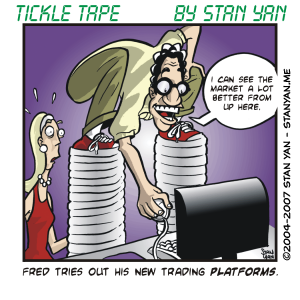A goal of every trader is to consistently earn substantial profits. It’s hard to achieve this goal, however. The only way it can be done is through persistence and practice. Many are drawn to trading, but few can actually trade for a living. This is a discouraging fact of trading, but one need not dwell on it. When one first embarks on a trading career, it makes little sense to immediately rule out the possibility of making huge profits. You don’t know whether or not you will be one of the few who will make the grade.
In the meantime, it’s useful to focus on more short-term, immediate goals: you should focus on learning reliable trading strategies, building up trading skills, and identifying personal-psychological limitations that may impede your performance. And perhaps the best piece of advice a novice trader can follow is to focus on the few key things that one is doing right, use that as a foundation, and then build up your trading skills, and your self-confidence, from there.
Even the least profitable trader does something right. For example, a trader may know how to find a good trading opportunity, but may not have the proper capital to make it pay off. Other traders may leave too much of their trading plans unspecified, and thus, while under pressure to perform, they may have difficulty executing the plan in an effortless, mechanical fashion. Still, others may use reliable trading strategies and delineate clear trading plans, but they may allow their emotions to undermine their efforts. Regardless of the basic limitation, the key to turning an unprofitable technique into a profitable one is to focus first on the elements that are working. In other words, perfect what you do best.
Identify what you are doing right, and make sure that you continue to do it over and over again. For example, if you know how to pick, and use, a particular indicator that works under a specific set of market conditions, stick with it. Don’t move back and forth until you are certain you’ve mastered the use of the indicator. Once you’ve mastered the technique, you can build on it. You can focus on other parts of your method that need fixing. Have you accounted for all possible adverse events that may go against your plan? Have you clearly specified an entry strategy, exit strategy, and risk control strategy?
Once you have a few key ingredients in place that work for you, you can look at what you’re doing wrong. Perhaps you are a little too emotional and choke under the pressure of executing your plan. Once you have part of your technique mastered, such as a winning trading strategy, you can address a different aspect of your trading, such as gaining control over your emotions. You can then try out ways of gaining control over your emotions, such as reducing your position size to such a minuscule amount that it won’t affect you emotionally.
You may want to use the automatic settings on your trading platform, or leave specific instructions with your broker. (Remember, at this stage, you’re just trying to build up your skills; you don’t have to be profitable yet.) Again, the key is to identify the parts of your trading methods that work and make sure you do what works consistently without alteration. Once you’re absolutely sure that you have these key components mastered, you can then move on to fixing other parts of your technique. But don’t make the mistake of trying to change too much at once. After you find something that works, stick with it.
Many seasoned traders, in recounting how they learned to trade, say they took the greatest hits to their trading account when they tried to trade in market conditions where they had not yet developed solid, reliable skills. For example, a trader may have mastered trading only during the first few hours after the markets open. Rather than sticking with what they did best, they moved on to other methods too quickly.
Even though they had made consistent profits during the opening hours of the markets, they decided to trade during the close, a time when they had no experience. When they tried to trade the close, however, they lost money. It’s important that one tries to expand one’s skills by trying out different strategies under various market conditions, but it is also important to take small steps. Wait until you are ready. Don’t move ahead too fast.
Trading profitably requires self-evaluation and practice. It’s necessary to identify which parts of your method are working and which parts are not. The key to improvement, however, is to identify what you are doing correctly and slowly building upon this foundation. By doing what you do best as much as possible, you’ll soon develop a method that will produce consistently profitable results.


